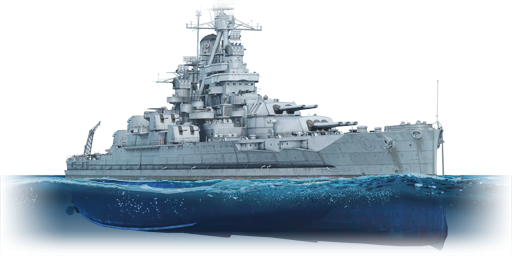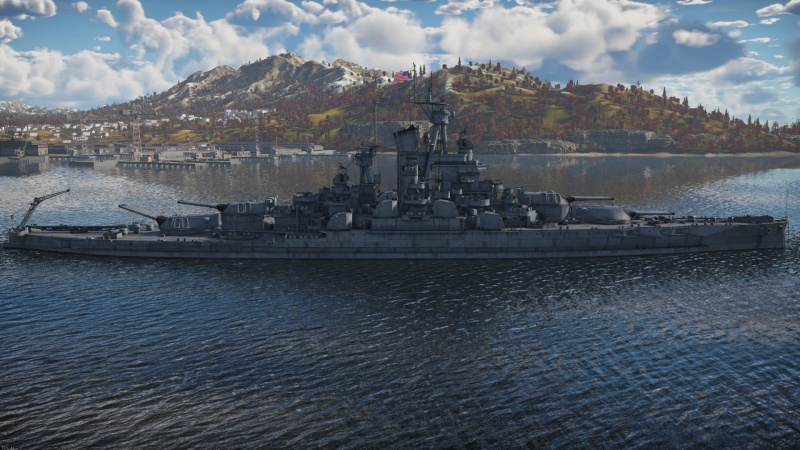USS Nevada
Contents
Description
The Nevada-class, USS Nevada (BB-36), 1944 is one of two Nevada-class battleships built for the US Navy, laid down in 1912 and commissioned in 1916. USS Nevada was commissioned first, making her the first "Standard-Type" battleship. Her innovations would be carried forward into the future American battleships, including triple gun turrets and the introduction of the "all-or-nothing" armour scheme. She would serve with distinction through both World Wars, seeing extensive combat action during World War II in particular.
She was introduced into War Thunder in Update "Sky Guardians", and although having a slightly smaller main battery than the later USS Arizona, she stands out with her incredibly strong secondary and anti-aircraft batteries. Coming in her late war refit, USS Nevada gives American bluewater captains their first battleship with both strong firepower, and the ability to easily fend off air attack. This does come with the caveat of having at minimum a 40 second reload on the main battery; it's recommended to keep enemies at a distance where the long time between salvos can be mitigated.
General info
Survivability and armour
USS Nevada is a very well-armoured battleship. Like other American battleships of the time, she was designed to be able to resist guns similar to her own 14-inch guns at expected battle ranges. This gives her a main armour belt of 13.5 inches, the same as the later USS Arizona. Keep in mind that "expected battle ranges" as designed were usually much further than what is typical in War Thunder, so Captains can't always expect their armour to hold up against guns such as the British 13.5 inch and the various 14-inch guns; albeit 12-inch shells should usually be stopped. The belt goes from 13.5 inches at the waterline, to 8 inches slightly below the waterline and 3 inches further down. This leads into the torpedo protection, which on Nevada protects against torpedos with warheads of up to 250 kg explosive mass.
The best armoured area on the ship are the turrets; the angled 16-inch plates on the turret faces are almost impenetrable, the 43 degree angle making it incredibly unlikely for any fire to penetrate the face. The armour is lighter on the sides, rear and top with 10-inches, 9-inch, and 5-inches on top. This leaves the sides and top of the turrets vulnerable to even heavy cruisers, so it's recommended to be cautious of exposing the sides of the turrets. The barbettes also have 13 inches of armour, which is quite good, more than most battleships of the same rank. The magazines are placed slightly below the waterline and against the waterline, mostly shielding them from enemy fire; however shots on a flat trajectory directly above the waterline do pose a slight risk of ammorack.
USS Nevada was the first ship ever to use the "all or nothing" armour scheme. This armour philosophy uses the most armour in critical areas like the citadel, and none other areas. This is perfect for fighting enemy capital ships at range, as AP shells will pass through unimportant areas that lack armour armour without fusing, and allows for the thickest possible armour over important sections of the ship. However, keep in mind that this also makes the unprotected areas of the ship vulnerable to taking damage from smaller ships, even destroyers. These areas may not be important, but crew still resides in these areas and constant repairing will still bleed the USS Nevada of crew, even more so on Nevada since she has so many secondary and anti-aircraft guns.
Mobility
Write about the ship's mobility. Evaluate its power and manoeuvrability, rudder rerouting speed, stopping speed at full tilt, with its maximum forward and reverse speed.
| Mobility Characteristics | |||
|---|---|---|---|
| Game Mode | Upgrade Status | Maximum Speed (km/h) | |
| Forward | Reverse | ||
| AB | |||
| Upgraded | 44 | 27 | |
| RB/SB | |||
| Upgraded | 38 | 23 | |
Modifications and economy
Armament
Primary armament
Provide information about the characteristics of the primary armament. Evaluate their efficacy in battle based on their reload speed, ballistics and the capacity of their shells. Add a link to the main article about the weapon: {{main|Weapon name (calibre)}}. Broadly describe the ammunition available for the primary armament, and provide recommendations on how to use it and which ammunition to choose.
| Penetration statistics | |||||||
|---|---|---|---|---|---|---|---|
| Ammunition | Type of warhead |
Penetration @ 0° Angle of Attack (mm) | |||||
| 1,000 m | 2,500 m | 5,000 m | 7,500 m | 10,000 m | 15,000 m | ||
| Mk.9 HE | HE | 71 | 71 | 71 | 71 | 71 | 71 |
| Mk.8 APCBC | APCBC | 637 | 597 | 536 | 484 | 439 | 372 |
| Shell details | ||||||||||||
|---|---|---|---|---|---|---|---|---|---|---|---|---|
| Ammunition | Type of warhead |
Velocity (m/s) |
Projectile mass (kg) |
Fuse delay (s) |
Fuse sensitivity (mm) |
Explosive mass (TNT equivalent) (kg) |
Ricochet | |||||
| 0% | 50% | 100% | ||||||||||
| Mk.9 HE | HE | 823 | 635 | 0 | 0.1 | 46.67 | 79° | 80° | 81° | |||
| Mk.8 APCBC | APCBC | 823 | 635 | 0.035 | 17 | 15.24 | 48° | 63° | 71° | |||
Secondary armament
Some ships are fitted with weapons of various calibres. Secondary armaments are defined as weapons chosen with the control Select secondary weapon. Evaluate the secondary armaments and give advice on how to use them. Describe the ammunition available for the secondary armament. Provide recommendations on how to use them and which ammunition to choose. Remember that any anti-air armament, even heavy calibre weapons, belong in the next section. If there is no secondary armament, remove this section.
| Penetration statistics | |||||||
|---|---|---|---|---|---|---|---|
| Ammunition | Type of warhead |
Penetration @ 0° Angle of Attack (mm) | |||||
| 1,000 m | 2,500 m | 5,000 m | 7,500 m | 10,000 m | 15,000 m | ||
| AAC Mk.34 | HE | 36 | 36 | 36 | 36 | 36 | 36 |
| Common Mk.32 | Common | 124 | 103 | 77 | 58 | 46 | 37 |
| SP Common Mk.46 | SP Common | 150 | 125 | 93 | 71 | 56 | 45 |
| AAVT Mk.31 | HE-VT | 36 | 36 | 36 | 36 | 36 | 36 |
| Shell details | ||||||||||||
|---|---|---|---|---|---|---|---|---|---|---|---|---|
| Ammunition | Type of warhead |
Velocity (m/s) |
Projectile mass (kg) |
Fuse delay (s) |
Fuse sensitivity (mm) |
Explosive mass (TNT equivalent) (g) |
Ricochet | |||||
| 0% | 50% | 100% | ||||||||||
| AAC Mk.34 | HE | 792 | 25 | 0 | 0.1 | 3,220 | 79° | 80° | 81° | |||
| Common Mk.32 | Common | 792 | 24.49 | 0.01 | 6 | 1,150 | 47° | 60° | 65° | |||
| SP Common Mk.46 | SP Common | 792 | 25 | 0.01 | 6 | 906.5 | 48° | 63° | 71° | |||
| Proximity-fused shell details | ||||||||||||
|---|---|---|---|---|---|---|---|---|---|---|---|---|
| Ammunition | Type of warhead |
Velocity (m/s) |
Projectile mass (kg) |
Fuse delay (s) |
Fuse sensitivity (mm) |
Arming distance (m) |
Trigger radius (m) |
Explosive mass (TNT equivalent) (g) |
Ricochet | |||
| 0% | 50% | 100% | ||||||||||
| AAVT Mk.31 | HE-VT | 792 | 25 | 0 | 0.1 | 457 | 23 | 3,220 | 79° | 80° | 81° | |
Anti-aircraft armament
An important part of the ship's armament responsible for air defence. Anti-aircraft armament is defined by the weapon chosen with the control Select anti-aircraft weapons. Talk about the ship's anti-air cannons and machine guns, the number of guns and their positions, their effective range, and about their overall effectiveness – including against surface targets. If there are no anti-aircraft armaments, remove this section.
Scout plane
Usage in battles
Describe the technique of using this ship, the characteristics of her use in a team and tips on strategy. Abstain from writing an entire guide – don't try to provide a single point of view, but give the reader food for thought. Talk about the most dangerous opponents for this vehicle and provide recommendations on fighting them. If necessary, note the specifics of playing with this vehicle in various modes (AB, RB, SB).
Pros and cons
Summarise and briefly evaluate the vehicle in terms of its characteristics and combat effectiveness. Mark its pros and cons in the bulleted list. Try not to use more than 6 points for each of the characteristics. Avoid using categorical definitions such as "bad", "good" and the like - use substitutions with softer forms such as "inadequate" and "effective".
Pros:
Cons:
History
Describe the history of the creation and combat usage of the ship in more detail than in the introduction. If the historical reference turns out to be too long, take it to a separate article, taking a link to the article about the ship and adding a block "/History" (example: https://wiki.warthunder.com/(Ship-name)/History) and add a link to it here using the main template. Be sure to reference text and sources by using <ref></ref>, as well as adding them at the end of the article with <references />. This section may also include the ship's dev blog entry (if applicable) and the in-game encyclopedia description (under === In-game description ===, also if applicable).
Media
Excellent additions to the article would be video guides, screenshots from the game, and photos.
See also
Links to articles on the War Thunder Wiki that you think will be useful for the reader, for example:
- reference to the series of the ship;
- links to approximate analogues of other nations and research trees.
External links
| USA battleships | |
|---|---|
| Delaware-class | USS North Dakota |
| Wyoming-class | USS Wyoming · USS Arkansas |
| New York-class | USS Texas |
| Nevada-class | USS Nevada |
| Pennsylvania-class | USS Arizona |
| New Mexico-class | USS Mississippi |
| Tennessee-class | USS Tennessee |





